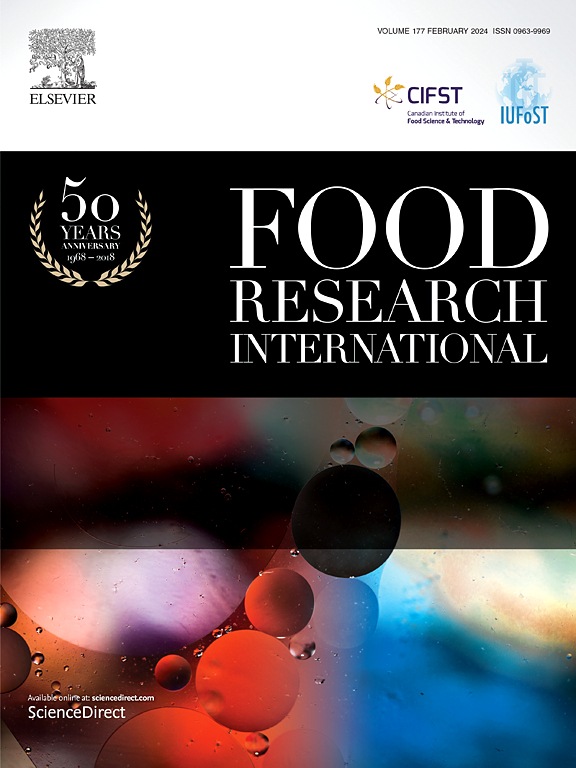Study of changes in volatile flavor substances during the processing and storage of mutton ham
IF 7
1区 农林科学
Q1 FOOD SCIENCE & TECHNOLOGY
引用次数: 0
Abstract
This study systematically characterized the volatile profile of dry-cured mutton ham to elucidate the dynamic changes of its characteristic aroma compounds during processing and storage. Using complementary analytical approaches, gas chromatography-olfactometry-mass spectrometry (GC-O-MS) and headspace-gas chromatography-ion mobility spectrometry (GC-IMS) identified 69 and 70 volatile organic compounds (VOCs) during processing, respectively, with 63 and 82 VOCs detected during storage. Key odor-active compounds including 6-methylheptanol, benzaldehyde, 2-nonone, 2-hexanone, and 2-heptanone were identified as major contributors to the ham's aroma profile. Notably, the aroma characteristics evolved significantly during storage, developing intense sweet orange, earthy, and roasted notes. Multivariate analysis via partial least squares regression (PLSR) revealed significant correlations between VOCs and specific lipid species: PE (16:1/20:4), PE (24:0/18:1), PE (22:6/18:0), PC (18:3/14:1), PS (18:0/22:6), and SM (d18:1/26:1). The results demonstrate that lipid degradation initially dominated during processing, followed by progressive oxidation that became more pronounced during storage. This sequential transformation ultimately enhanced the development of characteristic volatile flavors in mutton ham.

羊肉火腿加工与贮藏过程中挥发性风味物质变化的研究
本研究系统表征了干腌羊肉火腿的挥发性特征,以阐明其特征香气化合物在加工和储存过程中的动态变化。采用互补分析方法,气相色谱-嗅觉-质谱法(GC-O-MS)和顶空-气相色谱-离子迁移谱法(GC-IMS)在加工过程中分别鉴定出69种和70种挥发性有机化合物(VOCs),在储存过程中分别检测到63种和82种挥发性有机化合物。主要的气味活性化合物包括6-甲基庚醇、苯甲醛、2-壬酮、2-己酮和2-庚酮,被确定为火腿香气特征的主要贡献者。值得注意的是,在储存过程中,香气特征发生了显著的变化,形成了强烈的甜橙味、泥土味和烘烤味。通过偏最小二乘回归(PLSR)的多变量分析发现,VOCs与PE(16:1/20:4)、PE(24:0/18:1)、PE(22:6/18:0)、PC(18:3/14:1)、PS(18:0/22:6)和SM (d18:1/26:1)具有显著的相关性。结果表明,脂质降解最初在加工过程中占主导地位,随后是在储存过程中变得更加明显的渐进式氧化。这种顺序的转变最终促进了羊肉火腿特有挥发性风味的发展。
本文章由计算机程序翻译,如有差异,请以英文原文为准。
求助全文
约1分钟内获得全文
求助全文
来源期刊

Food Research International
工程技术-食品科技
CiteScore
12.50
自引率
7.40%
发文量
1183
审稿时长
79 days
期刊介绍:
Food Research International serves as a rapid dissemination platform for significant and impactful research in food science, technology, engineering, and nutrition. The journal focuses on publishing novel, high-quality, and high-impact review papers, original research papers, and letters to the editors across various disciplines in the science and technology of food. Additionally, it follows a policy of publishing special issues on topical and emergent subjects in food research or related areas. Selected, peer-reviewed papers from scientific meetings, workshops, and conferences on the science, technology, and engineering of foods are also featured in special issues.
 求助内容:
求助内容: 应助结果提醒方式:
应助结果提醒方式:


